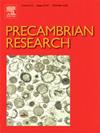Ediacaran glacial records identified from the southern Alxa Block in NW China: Evidence from stratigraphy and C-O isotopes
IF 3.2
2区 地球科学
Q2 GEOSCIENCES, MULTIDISCIPLINARY
引用次数: 0
Abstract
The Ediacaran-age glaciation is the last of three major glacial events during Cryogenian-Ediacaran time. Unlike the earlier Cryogenian-age Sturtian and Marinoan glaciations that deposited worldwide diamictite and cap carbonate couplets, the Ediacaran-age glacial cap carbonates have rarely been documented, which hinders the understanding of Ediacaran glaciation and glacial stratigraphic correlations. Here, we newly identified an Ediacaran glacial cap carbonate overlying the stratified diamictites in the upper part of the Shaohuotonggou Formation in the Neoproterozoic Hanmushan Group along the southwestern margin of the Alxa Block. The stratified diamictite with unsorted clasts and widespread ice-rafted dropstones indicates its glacial origin. The absence of glacial-interglacial depositional cycle suggests that no glacier advance-retreat process occurred during this glaciation, which likely represents a short-lived glacial event with rapid deglaciation. Carbon isotope values of the cap carbonate fluctuated between ca. −2.6 ‰ and ca. + 1.5 ‰, comparable to other Ediacaran glacial cap carbonates (ca. 560 Ma) from Arabia, Qaidam, northwestern Australia and Iran. Taking into account recently discovered Marinoan-age diamictite and cap carbonate couplet at the basal Shaohuotonggou Formation, we suggest that the southern Alxa Block most likely preserves two Neoproterozoic glacial events, i.e. the Marinoan-age glaciation and the late Ediacaran-age glaciation. Thus, the Shaohuotonggou Formation most likely represents a late Cryogenian–late Ediacaran succession that contains two intervals of glaciogenic deposits. The occurrence of Marinoan and Ediacaran glacial cap carbonates thus merits a reconsideration of the paleogeographic and paleoclimatic evolution in the Alxa Block during late Neoproterozoic time.
求助全文
约1分钟内获得全文
求助全文
来源期刊

Precambrian Research
地学-地球科学综合
CiteScore
7.20
自引率
28.90%
发文量
325
审稿时长
12 months
期刊介绍:
Precambrian Research publishes studies on all aspects of the early stages of the composition, structure and evolution of the Earth and its planetary neighbours. With a focus on process-oriented and comparative studies, it covers, but is not restricted to, subjects such as:
(1) Chemical, biological, biochemical and cosmochemical evolution; the origin of life; the evolution of the oceans and atmosphere; the early fossil record; palaeobiology;
(2) Geochronology and isotope and elemental geochemistry;
(3) Precambrian mineral deposits;
(4) Geophysical aspects of the early Earth and Precambrian terrains;
(5) Nature, formation and evolution of the Precambrian lithosphere and mantle including magmatic, depositional, metamorphic and tectonic processes.
In addition, the editors particularly welcome integrated process-oriented studies that involve a combination of the above fields and comparative studies that demonstrate the effect of Precambrian evolution on Phanerozoic earth system processes.
Regional and localised studies of Precambrian phenomena are considered appropriate only when the detail and quality allow illustration of a wider process, or when significant gaps in basic knowledge of a particular area can be filled.
 求助内容:
求助内容: 应助结果提醒方式:
应助结果提醒方式:


